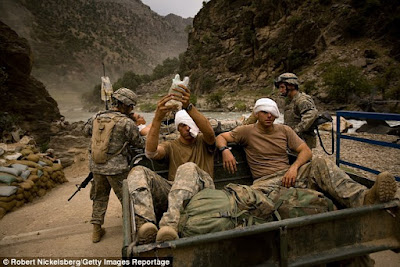Semper fi: Vietnam veteran salutes corpsman who saved his life
High Point Enterprise
Jimmy Tomlin
Aug. 02, 2014
ARCHDALE
For Welch, though he may not have realized it at the time, a new journey was just beginning. The day he was injured — Jan. 25, 1968 — redefined his life.
And that newspaper photo, which ran the next day, redefined his sense of gratitude.
One day in late January 1968, the High Point Enterprise published a somewhat grisly, front-page photograph of a wounded U.S. Marine, lying flat on his back at a first-aid station in South Vietnam.
The young soldier’s gritty face reflected the anguish he was in as a medical corpsman tended to his left ear, which had nearly been ripped from the Marine’s face by enemy rocket and mortar rounds.
“Shocked And Wounded,” the caption read, explaining that the corpsman was talking quietly to the injured Marine to calm him.
For most readers, it was just another grainy, black-and-white war photo — an Associated Press dispatch from a divisive conflict being staged some 9,000 miles from North Carolina.
For one High Point family, though, the photo hit close to home. The injured soldier, though not identified in the caption, was their son — Lance Cpl. William Michael “Mike” Welch.
LAURA GREENE | HPE
Marine Corps veteran Mike Welch, of Archdale, tracked down the corpsman who saved his life in Vietnam more than 45 years ago.
“Yeah, my dad saw it in the paper and recognized me, but he didn’t show it to my mother until about a week after I got wounded,” says Welch, now 65 and living in Archdale. “He was afraid my mom would flip out and have a heart attack or something.”
Joseph Grayson Welch tried desperately to find out what had happened to his son — and whether he was even still alive — all the while keeping the newspaper from his wife, Mildred, and hoping nobody else would recognize their son in the photo and call it to her attention.
One day, finally, a cab pulled into the Welches’ driveway on Brentwood Street — a universally understood sign that they were about to receive a telegram from the military about their son. To their great relief, Welch had not died, but the telegram reported he had sustained “fragmentation wounds to the left ear, neck, both hands, back and both buttocks, with an open fracture of the left arm.” Hostile mortar fire, the telegram said. His condition was listed as “serious,” his prognosis “guarded.”
Subsequent telegrams provided medical updates — and some measure of comfort — for Welch’s parents, who are now deceased.
read more here






